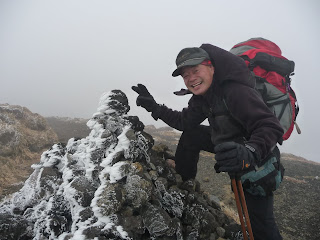This is my 2nd hike after Jan. 7th, 2006. JangAnSan is located about 1.5 hour-bus ride from Daejeon. There is DeokYuSan(1614m) National Park nearby.

[AhToSan hikers at Muryong Passムリョン峠の登山口にて무령고개에서 아토 단체 사진]
It was just like the previous hike, the trail was all covered with snow. But the facilities of Korean mountains have been improved rapidly. Now I see spacious wood steps and a big stone with the name of the mountain which I did not see last time.

[Snow-covered trail雪に覆われた登山路눈에 덮힌 등산로]
I could observe beautiful phenomena such as “wine glass” or “snow shrimp” made of frost at Mt. Aso last week. Now I saw art of ice like “glass sculpture” out of melted “soft rime” at JangAnSan.

[Glass-crupture like iceガラス芸術のような樹氷유리 예술과 같은 수빙]
Since this is the first hike after Lunar New Year, AhToSan Hiking Club performed “Beginning Hiking” ceremony near the top of the mountain. This ceremony is an annual event when they pray for the safety of our hiking to the god of mountain.

[Near the top of Mt. JangAn長安山頂上の近くで장안산 정상 가까이에서]
During the ceremony, they offer a lot of food including a head of pig, fruits, rice cake named “sil-ttok”, a dried cod, Korean wine named “Makkori” etc. I saw a head of pig offered by other hiking club, but AhToSan is more practical and they use big piece of meat of pig instead of head, so we could eat it after the ceremony.

[Ceremony by other club他の山岳会の始山祭の模様다른 산악회의 시산제 모양(Can you see a head of pig?]
They cut the top part of the fruits such as apples, pears, and persimmons flat, and you can observe such offering at similar ceremonies at home in Korea.
The leader of the club read the prepared “wishes” written on a paper, then burn it. Then he perform “big jeol” or Korean way of deep bow toward the alter. Then he offers money. (When they use a pig head, they put bills in the mouth of the pig.) Then members followed suit to the leader.

[The leader bows deeplyまず会長が祭壇に向かって礼をする우선 회장이 제단을 향해서 큰절]
We had lunch after the ceremony. The food was so plenty, we could not finish eating them. We always have a little party after the hike. This time, we had the leftover with Makkori for this occasion.
There were 27 participants including 4 foreigners (2 Russians, Mexican, and Japanese.) This is my 190th hike with AhToSan out of 255 AhToSan planned hikes since its establishment in September 2004.
2010年2月20日(土)
目的地:全北、長安山(1234.9m)
長安山は2006年1月7日に続いて2回目。
大田からはバスで2時間とかからない近距離にあり、有名な徳裕山のすぐ近くだ。

[The landscape near the top of Mt. JangAn長安山頂上の近くの風景장안산 정상 근처에서]
前回同様、雪深い山のハイキングになったが、登山路は前回に比べずいぶん整備されていた。また、山頂には立派な石標が建立されていた。

[At the top of Mt. JangAn長安山の頂上にて장안산 정상에서]
先週の阿蘇山では山頂付近で霧が強風で岩や草木に吹きつけられて凍った「エビのしっぽ」や「ワイングラス」のような自然の芸術を見たが、今回は樹氷が昼間解け、それが夜間の低温で再度凍った、ガラス細工のような氷の芸術を見ることができた。

[Glass-crupture like iceガラス芸術のような樹氷유리 예술과 같은 수빙]
また、旧正月が過ぎて最初のハイキングでもあり、アトサン山岳会は「始山祭(シサンジェ)」を執り行い、今年1年の無事を山の神に祈った。

[Well facilitated trail and the ridgeよく整備された登山路と尾根잘 정비된 등산로와 산등성이]
このような祭り事を行う場合、韓国では豚の頭をよく使う。他の山岳会ではよく使っているのをみるが、アトサンは事後に切ってすぐ食べることができるポークを使う。

[A head of pig used by other club他の山岳会が使った豚の頭다른 산악회가 사용한 돼지 머리]
豚肉のほかの供え物には、韓国式のアンコ餅とも言うべき「パッシルトック」また、ナシやリンゴやカキなどの果物の上部を平たく切ったものや、干したタラなどがある。これらは一般家庭で祭事を行う場合も同様である。

[Lunch time アトサンの昼食아토산의 점심 삭사]
供え物のごちそうは祭事が終わると皆で食べる。昼食で食べきれなかった分は、ハイキング終了後の「ティップリ」パーティでマッコリ(韓国のどぶろく)のつまみになる。

[After-the-hike partyアトサンのティップリ・パーティ아토산 되풀이 파티]
今回のハイキングには私のほか、ロシア人男女とメキシコ人が参加し、外国人は4名であった。彼らは「始山祭」を見るのは初めてのようで、興味深そうであった。

[Foreingers (Non-Koreans)今回参加した外国人たち이번참가한 외국인들]
アトサン山岳会は、今回の登山が255回目の企画であり、私にとって190回目の参加になる。



































